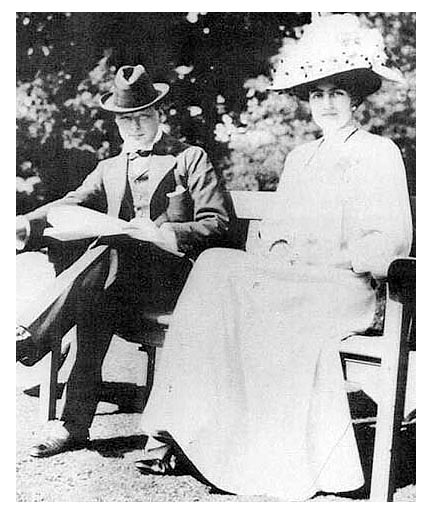
Clementine Hozier was all ready eating her chicken at a 1908 dinner party given by Lady St. Helier in Mayfair when Winston Churchill arrived late. Churchill became entirely absorbed by Clementine and paid her such marked and exclusive attention. He had never before met a fashionable young woman at a society dinner who earned her own living at age 22.

Churchill courted her for a short five months before they were married at St. Margaret’s Church in Westminster.. The bells of Big Ben struck two o’clock as Clementine entered the 15 Century white stone church. She had five bridesmaids. Their honeymoon was taken on Italy’s Lake Maggiore. Within a month of their return, Clementine was expecting a child.
Winston’s domineering mother, Jennie, and his new wife did not get along. Partly due to Winston’s preference for his mother, walking arm in arm, leaving Clementine feeling like an intruder.
Throughout their 56 years of marriage, this friction would cause great distances between husband and wife. The husband, Winston, was not the public statesman of courage. He was demanding, petulant, inconsiderate, and childish, toward Clementine. Winston craved comfort and protection. So did Clementine. There were frequent separations when one or the other would leave for months at a time to visit France or Italy. Clementine at times considered divorce.
They would produce five children and Clementine became accustomed to Winston’s frequent absences and work load. He was driven, narcissistic, intolerant, and did not think women should have the vote. In October 1911 Winston became the first Lord of the Admiralty, in those days a position of imperial grandeur. Clementine rose to their new status.
She took up hunting. She launched battleships with a regal grace. During WWI Clementine organized canteens for munitions workers and during World War II she acted as chair of the Red Cross Aid to Russia Fund, president of the YWCA War Time Appeal and served as chair person of the Maternity Hospital for the wives of officers. She was appointed a Commander of the Order of the British Empire (CBE) in 1918. She received the insignia of the Dame Grand Cross of the Order of the British Empire from the king at Buckingham Palace in 1946.
More than seven million British women worked during WWI and many for the first time which gave them a sense of liberation. Their new horizons could include more than husbands, parties, or homes. Clementine was one of those women.
Throughout the marriage Winston maintained his relationship with Violet Asquith telling her that “the duties of women specifically include tending men at the apex of responsibility.” Needless to say, Clementine viewed Violet as a threat and many years later, the two became friendly with their mutual interest in Winston.
Finances were another part of their domestic issues because they spent more than their income at any given time and were almost at the edge of bankruptcy several times. They moved frequently. Holidays together were rare because they could not agree on companions or on destinations. A pair hardly well-matched. Publicly, however, Clementine said “we have made up our minds to do our duty whatever may befall.”
Winston Churchill could be reckless, over-sentimental, self-absorbed, devoid of empathy and vainglorious. He became a supreme statesman with his all-consuming commitment to the British Empire. Clementine had a strong personality who lived in a partnership with many highs and lows.
She was widowed January 24, 1965 when Winston died at age 90. Following Sir Winston’s death, Clementine was made a life peer as Baroness Spencer-Churchill of Chartwell in the County of Kent. Lady Spencer-Churchill died at her London home December 12, 1977 at age 92. She had outlived her husband by 13 years, as well as three of their five children.

